Istanbul Up Close
Amorphous(adv): having no definite form.
That which is formless and free-flowing and doesn’t conform to boundaries.
"On the meeting point of two worlds, the ornament of Turkish homeland, the treasure of Turkish history, the city cherished by the Turkish nation, Istanbul, has its place in the hearts of all citizens." - Mustafa Kemal Atatürk
Antiquity steeped in the modern metropolis- a gem like Istanbul is rare in common. Just like a gem on display, all come to see, but only wise travellers look underneath the surface to appreciate the pressure it endured and became a prized treasure. To understand this city, you have to go back in history, and history has been all kinds of cruel and kind to this unique city called Istanbul.
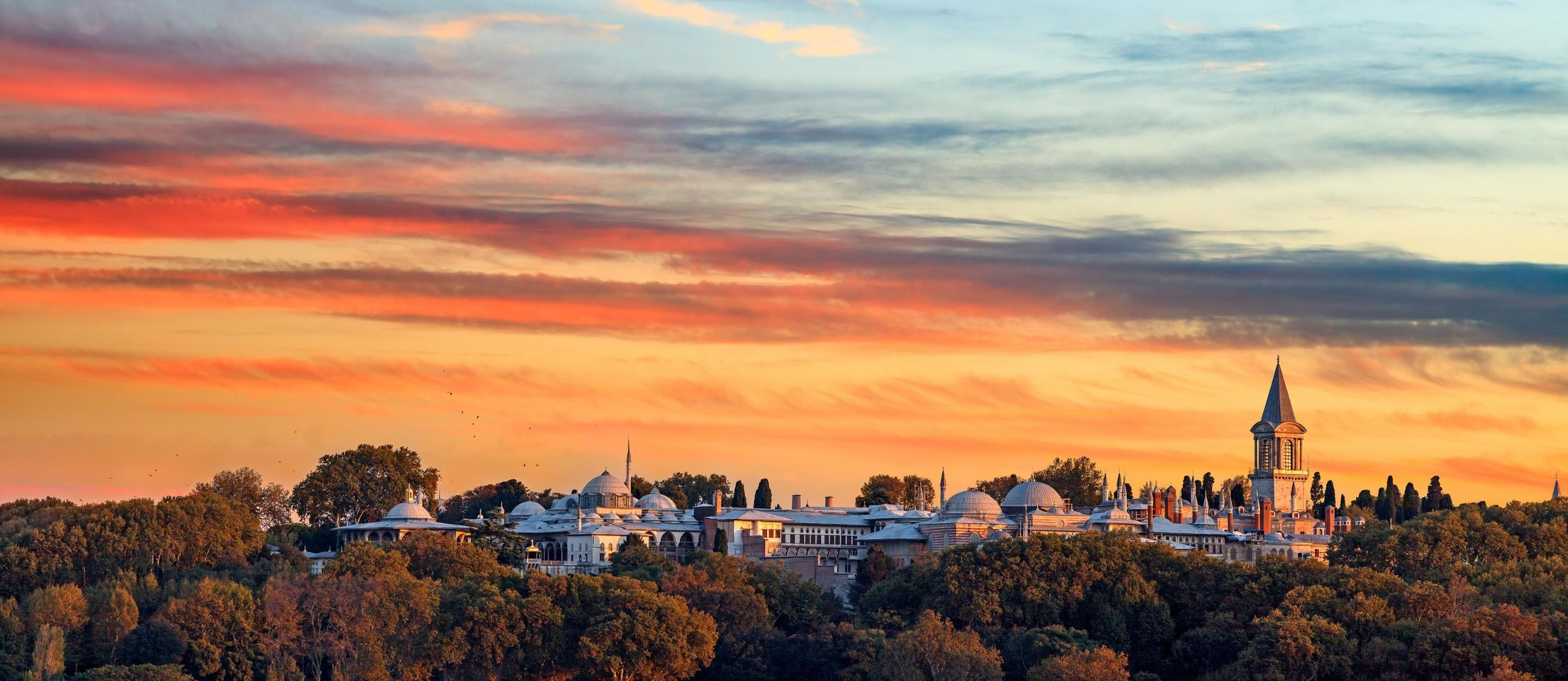 >
>
Becoming Istanbul
The first settlement and what followed in history is full of intrigues and sieges. It was one of the most coveted cities in the world and has seen numerous battles of the imperial powers trying to control it, from Byzas laying the claim in 7th century BC and calling it Byzantine till the arrival of the Persians who were overtaken by Alexander the Great by 4th century BC. A few centuries passed peacefully to be then conquered by Roman emperor Septimus Severus in the 2nd century AD. In the 4th century, emperor Constantine the Great made Byzantium the capital of the entire Roman Empire and renamed the land Constantinople. Byzantine rulers filled their city with the riches of the ancient world between the 4th and 6th centuries. In 532, under Justinian I regime, riots devastated the city. But Constantinople was rebuilt, and extraordinary monuments such as Hagia Sophia stand as a testament to the golden age of Byzantines. Arabs claimed this city for themselves in the 7th and 8th century, and then Barbarians did the same in the 9th and 10th, but a crippling time came with Fourth Crusade’s rule between 1204-1261, who ravaged the city and lay waste to its wonders looting all its wealth. After this destruction, Constantinople never gained its richness and power.

When Ottoman Turks conquered, led by Sultan Mehmet II in1453, he renamed the city Islambol and thus, it became the capital of the Ottoman Empire. Between the 15th and 16th centuries, sultans erected many mosques and public structures, increasing the population again by around half a million by the mid-1500's making Istanbul an important and strategic cultural, political, and trade centre. For thousands of centuries, Istanbul has stood the test of time, sometimes as a barrier and at times as a bridge witnessing the confluence of religion, culture and art, imperial reigns and visionaries.
“... haste can do nothing with these hills. I knew when I had looked for a long time that I had hardly begun to see.” ? Nan Shepherd, The Living Mountain
Take your time while travelling. To have the best trip possible when we’re actually on it, we need to stay loose. The days you will spend in Istanbul, immerse yourself into the culture by reading novels and poetry, watching films and surfing their fashion and cookery channel. Watching the news channel in between, you coming and going from your hotel room. You may not understand everything about what you see and hear, but your senses will absorb the essence of the place, opening doors to greater insights on a surreal level.

Every morning I got up with quiet energy around me, ready to leave my hotel and go in any one direction. Some days I travelled as far as 6 kilometres to see whatever there is to see in between. With the most important spots closely connected, it became easy to move about. When planning a trip, you cannot think of the things you will see in between your walk or your transportation from the airport to the hotel or from the hotel to visit an attraction. While anticipating a trip, we cannot imagine the people we will encounter and the little incidents that will happen, like a stranger picking up your bag for you, a helping hand by someone else while disembarking the ferry. The sights you will come across, such as the neighbourhoods where people go about their lives, a woman speaking to her children while another woman sits at a corner, having seen the better part of her life. A man in discussion with buyers for his fruits. Passing these scenes makes our time in these places all the more real, and that infuses life in our imagination of the country.

The Locality
Istanbul is a place flooded with generally nice and compassionate people. Most of them are extremely friendly to tourists and encourage the whole lot to explore their country better. They take their time in explaining and feel pretty pleased about it too. Making evident the sense of hospitality is deeply ingrained in them.
From a traveller’s point of view, people in Istanbul are going about their day, taking care of anyone they come across. Also, they cannot stand a helpless cat or dog. Turkey is a place known for its caretaking attributes of stray animals; many feed them daily or immunise them just the same.
Common in Istanbul is men holding conversations over their famous Turkish tea. Discussions, including politics and topics from all around the country, aren’t rare to watch the locals getting involved in. A country where the old and new are mixed together, the places in Istanbul range from being quiet to extremely noisy with all the hustle and bustle in the world. For instance, the Talimhane district near Taksim Square is a fairly quiet area with 3 to 4-star hotels. On the other hand, however, the modern side of Istanbul in Galata is a highly vibrating neighbourhood full of energy.

Pay a visit here, check out the food joints next to monuments, and sit outside the café to watch the tourists moving in and around the place. Go to the shops and see what they sell. Buy local things, talk to the shopkeeper and pick his brains if you are buying; he sure will entertain you.
“It is discouraging to try to penetrate a mind like yours. You ought to get it out and dance on it. That would take some of the rigidity out of it.” ? Mark Twain
Learn not to be too rigid while travelling; by being agile with your itinerary, you will let in the experiences waiting to reveal themselves to you. Being very rigid and planning meticulously with attention only to its execution will put you at risk for unfavourably comparing your expectations to the real thing.
One of the best places to be in Istanbul is inside the Kapali Çarsisi, the Great Covered Bazaar. Equally important to know the best time for your visit is when you are in an excellent jovial mood, and so I took my time to fall in beat with the city vibe and then I took off wearing comfortable shoes, an umbrella and a big empty bag ready to be cajoled into emptying my wallet and filling the bag. The easiest way to get to it from the Book and Paper Market is to leave it by the Hakkakalar Kapisi, the Gate of the Engravers, and cross Cadirçilar Caddesi, the Street of the Tent-makers, which is lined with booths occupied by tin- and copper-smiths and is perpetually blocked by people and vehicles loading and unloading. This is a fascinating street. No one makes tents there anymore, but any one of the owners of the booths in it will sell you old brass and iron objects. Or make you a fine tin stove or an oven for your house. You cross this street and go through the Gate of the Fez makers, Fesçilar Kapisi, into the shallow, uphill end of the Kapali Çarsisi if books make you remember your college days, visit Istanbul University, a 5 -10 minute walk from here.

These ancient arcades of Grand Bazaar are one of the largest and oldest covered bazaars in the world. The Grand Bazaar is 30,700 square meters with over 60 streets and alleys and 4,000 shops. The original historical core of the bazaar, Iç Bedesten, was completed by Mehmet the Conqueror in 1461. A “bedesten” refers to an indoor arcade with shops, and there are several areas within the bazaar referred to by this name.
Inside, under the vaulted ceilings, things got more interesting. Everything mingled: the old, new, cheap, extravagant. There were hills of spices and dried fruit-apricots, mulberries, mangos, grapefruits, pineapples, strawberries, ginger, cranberries-and bins of colourful tea in flavours like kiwi, lemon, apple, and orange. There were boxes of lokum (Turkish delight) flavoured with fig-walnut and apricot, almond and honey. There were baskets filled with pastries the colour of pale roses and glass display cases with even more lokum, this time formed into logs, and in more variations of pistachio flavours than I knew possible: grape pistachio, milk pistachio, honey pistachio. Chatting and bargaining with the sellers, who often are fluent in more than one language, make the Grand Bazaar experience different. Experience the Grand Bazaar at a leisurely pace; often, it feels like sensory overload, especially for first-timers when the vendors aggressively try to close the sale.
The difficulty that most travellers experience when visiting the bazaar is the absence of its plan that gives an idea of its layout or the orientation of its streets, except an excellent guide book, a GPS or your patience in asking at every turn which way is what and which way to come out from.
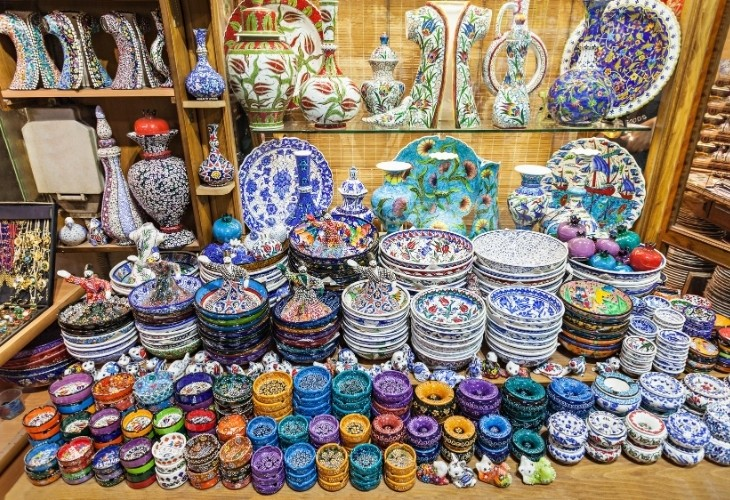
In the maze of covered streets, merchants called out as I passed, pools of light illuminating gold bangles, scarves, ceramics, and hookahs for sale. Many shops were not unlike mall boutiques, with electric signs, glass storefronts, and shelves of accessories and housewares. Outdoors, under tarps and awnings, were entire streets lined with stalls selling cookware and household sundries (brooms, feather dusters, honey wands). Some of the items, whether an economy-size pack of sponges or a wood chair, dangled like piñatas from ropes above shoppers' heads.
Opening days: The Grand Bazaar is closed on Sundays and Turkish public holidays.
Cihangir: a neighbourhood that’s home to writers and artists.
“It was in Cihangir that I first learned Istanbul was not an anonymous multitude of walled-in lives - a jungle of apartments where no one knew who was dead or who was celebrating what - but an archipelago of neighbourhoods in which everyone knew each other.” ? Orhan Pamuk, Istanbul: Memories and the City
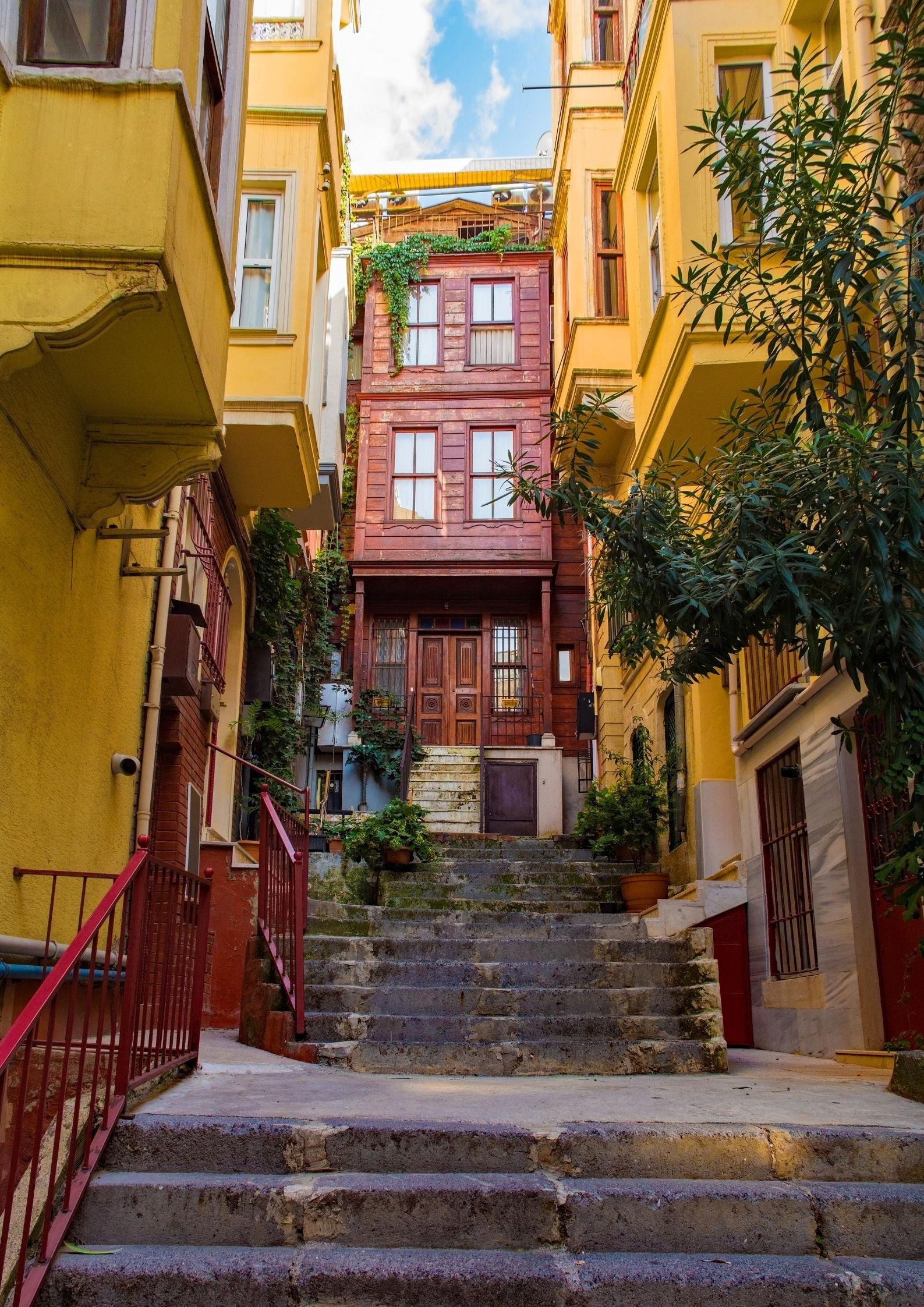
Only a few Istanbul neighbourhoods today constitute the surviving historic quarters of the old city even though they have lost many of their original characteristics, which made them genuinely old Istanbul neighbourhoods. No doubt, these characteristics were those reflecting the spirit of Istanbul’s past, a past that has already faded away. What remains for sure today is, to me, the soundness of an idea that in fact, the story of each such neighbourhood may well be the story of cosmopolitan Istanbul, a summary of the changes it has gone through, the times through which it has lived. Istanbul's Beyoglu district: artists, writers, actors and ex-pats, drawn by the area's culture and equally lofty Bosphorus views. (Orhan Pamuk's office is here.)
The bohemian lifestyle is palpable amid the neighbourhood’s narrow streets covered in greenery, eclectic street cafés, and delightful clothes and food boutiques. The area is one of the prettiest in the city and sorted out for its Café culture. Turkish cuisine is best experienced at a meyhane, a kind of taverna. An array of cold starters or meze are brought to you on a platter (with an emphasis on vegetables cooked in olive oil and seafood), hot starters with a choice of grilled calamari, shrimps or octopus is served next, followed by a selection of fresh fish. All of this is served with raki; the anise flavoured distilled grape spirit that is Turkey's national tipple.

In contemporary Istanbul, Cihangir positions itself, albeit a bit commercialized but nevertheless nostalgic for a past cosmopolitan urban tableau. As I had extensively read Istanbul: Then and Now and being a huge fan of Mr Pamuk, I went up the hill to the Museum of Innocence - a showcase of what we try to keep and what we eventually lose. Ever been a trip down memory lane even when you don’t have the memories you’re experiencing? Exactly. Leaving the museum and walking downhill to the dazzling Bosporus was like re-entry into the living after a brief limbo.
Eminönü
Eminönü contains one of the best Spice Bazaar you will find in the world. Despite bearing the brunt of two fires that damaged heavily, it is the second-largest closed bazaar in Istanbul. Where the Grand bazaar is the largest and has a raw oriental feel, the Spice market is more delectable and architecturally more prominent. In the middle 18th Century, the market was called Misir Çarsisi, where goods from Egypt were sold here. Later, as more and more spices were sold, it came to be known as Spice Bazaar.
Eminönü is one of the city's busiest ferry stops, though each stop features its colourful harbour scenes: During the day, locals fish and sell everything imaginable on this bridge between Eminönü and Beyoglu. Underneath are restaurants and cafes; enjoy Turkish coffee and chestnuts while watching the ferries approaching the nearby ferry docks. Nearby, the clock towers of the Sirkeci Terminal, once the final stop on the Orient Express, rose beside an empty train car. The domes of vast mosques shined in the sunlight.

Walking over the bridge at sunset from Eminönü to Beyoglu, you will find the scenery rapidly changing. From men selling flowers from pushcarts and tents; ageing shoe shiners sitting behind their brass boxes under trees and umbrellas; yellow taxis idling at the curb slowly transitions into where the Galata Tower stands. Seagulls circle the tower against a soft red-pink sky, offering a spectacular view of the peninsula. The narrow streets of Galata are lined with trendy eateries serving local and regional food. The scent of apple tobacco wafts out of the nargile cafes under the bridge crowded with young travellers from various nationalities.

It is Galata Tower where Hezârfen Ahmed Çelebi flew from. He is the first man ever to fly using wings, crossed the Bosporus and landed on Üsküdar.
Quite noticeable in Istanbul is how the city is a concoction of different elements. It may come off as a tad bit confusing that the city is modern and old-fashioned at the same time. The environment changes swiftly, going from one part to another. This typically roots from the fact the Istanbul is built on two continents- Europe and Asia. A mix of influences is bound to be inevitable. Some of the places in Istanbul take you back in time to the Ottoman Empire's glory days. Whereas walking past the culturally rich streets of Istanbul is nothing but feelings drenched in pleasure.


Street photography is also a visible aspect of life in Istanbul, with tourists and locals indulging in capturing the moments all the same.
Ones to Visit
Turkey boasts immense beauty and remarkable history of legends who left an indelible mark on the country. Istanbul has been inhabited by civilization since the 6th century BC. Byzantine, Persians, Alexander the Great, Roman, the Ottoman Empires and many tribes and nomads on the fringes all of them have brought about the existence of ancient structures, historic monuments, royal palaces, museums etc. Each of these edifices exhibits their distinguishing features from their different makers, and yet they stand together in their diversity, showing Istanbul’s acceptance and tolerance for societies of all faiths.

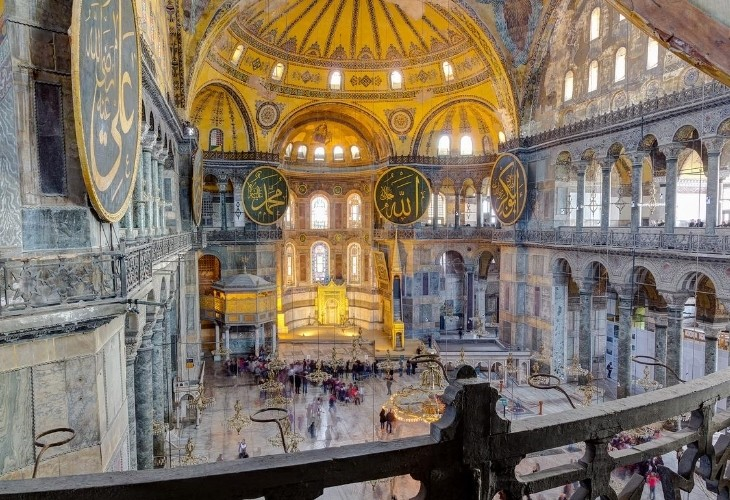
For starters, Aya Sofya or formerly known as Hagia Sophia, although now converted into a museum, had been Istanbul’s most treasured mosque since 1453. It’s pretty obvious why some call it the eighth wonder of the world, being such a massive architecture of masterful engineering. The mosque has a magisterial interior with ceilings covered in mosaic. Surely a jaw-dropping sight for all the tourists that step on the not-so-humble abode. In its courtyard, there’s an inscription that translates to, “Wash your sins and not only your face.” It was built with the dedication to impress, consisting of marbles that came from all over the Turkish empire back in time.
“Oh! What treasures you hold Topkapi!”
Entering one of Istanbul’s marvels, Topkapi Palace is a place not to be rushed when visiting. This is mainly because it takes half of one’s day to experience the place in full. Being an elite class, highly decorated palace, it has been home to the Ottoman Empire's Sultans for centuries. Today, it serves as one of the most dazzling places one could ever live up to see in their lifetime, at least for me. It contains within its gold-embroidered walls Islamic relics held in the highest regard. Furthermore, the whole structure itself is representative of Islamic art. If you are a lover of all things fine and invaluable or want to marvel at the Holy artefacts, then don’t miss the Third Court. The Dormitory of the Expeditionary Force holds imperial robes, talismanic shirts, kaftans and uniforms worked in silver and gold thread. Did you know The Chamber of Holy Relics house relics of the Prophet, including the mantle, sword, and bow of the Prophet Muhammad, all of which were obtained when Selim I conquered the Mamluk dynasty in Egypt in 1517, passing the caliphate to the Ottomans? As incredible as it, Topkapi also houses the pot of Abraham himself, the staff of Moses, and the sword of David are all on display in the room, along with scrolls that were possibly John the Baptist’s and a turban said to have belonged to Joseph, son of Jacob. The Treasury protects an unbelievable collection of items decorated with gold, silver, rubies, emeralds, jade, pearls and diamonds. The most famous is the Topkapi Dagger, the topic of intrigue in the 1964 caper film Topkapi.

Another delightful sight where one closely interacts with Istanbul’s locals is the Grand Bazaar. Crowned as one of the world's largest markets, the Grand Bazaar hosts more than a quarter-million tourists every day to its striking speciality. With more than 5000 stores and 11 gates for entrance, the place is full of Turkish tradition. Exceptional spices, succulent fruits and vegetables, luxurious carpets, eccentric Turkish lamps, and novel Turkish scents, to name a few royalties available for purchase in Turkey’s famous Grand Bazaar. Also, Istanbul’s highly intriguing local skill of making Ceramics and Tiles make a lot of tourists fall prey to its excellence. They are compelled to make a purchase and take these handicrafts back home with them.

Besides the grandeur of the most opulent tourist sites in Istanbul, the city is also a sensation in local attractions. Sultanahmet Square, for one, is the place to be in for all types of entertainment. Most people who come to Istanbul just spend their time exploring the square due to its excessive width. Sultanahmet Square is also situated in a place nearby to other top tourist sites.
From a plethora of such Mosques, Museums, Palaces and timeless bazaars, Istanbul thrives unapologetically for its culinary mastery, inspiring millions to come and partake of food unparallel in comparison in the world of gastronomy.
The Luscious Food

You might have heard of the words “Turkish Cuisine”. That’s right, the food of Turkey didn’t become so renowned for no reason. It has achieved the status of being world-famous as none could compare to its distinct class. Although food like the Turkish Breakfast is something you could find in a fancy restaurant in Istanbul, the wider masses in tourism are about the delicious street food.
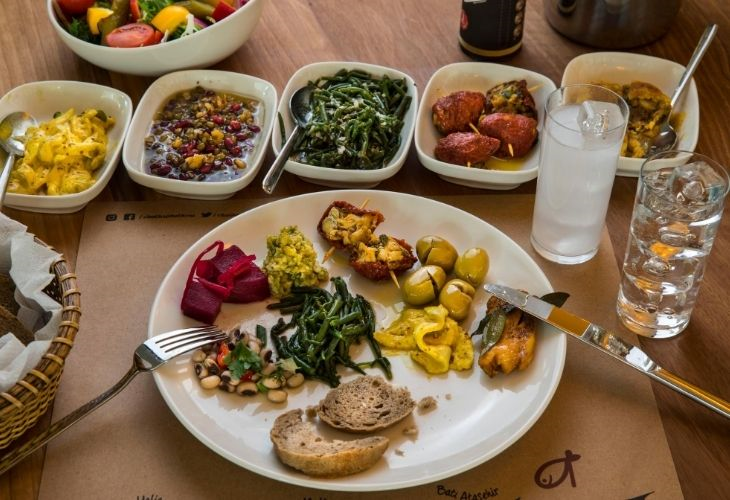

For starters, Doner Kebab is well-known throughout Istanbul. This is served with either chicken or beef stacked in bread with vegetables. You could find a Doner Kebab stall every 20 meters in Istanbul but right alongside Grand Bazaar is Donerci Sahin Usta, one of the best Doner Kebab makers out there. A little bit pricey than your average Doner but worth every single penny.


Moreover, Kokorec and Midye Dolma are Turkish snacks that can be found on Istiklal Street. A sweet called Baklava is one of Istanbul’s finest found almost everywhere, but for the best Baklava in Istanbul, one should only need to go to Hafiz Mustafa near Sultanahmet.
Only in Istanbul
Given enough time to a place, there are a few unique occurrences that come forth to the traveller’s surprise.
One such fascination takes place in Gülhane Park in Istanbul. Upon an exciting visit, a high-pitched chirp of the numerous birds there is sure to be heard. These birds are ring-necked parakeets naturally ranging in Asia and Africa; the question here is how did they end up in Istanbul? It is said that maybe a smuggler had a truck accident and the birds escaped or who knows? The birds being highly talkative, one’s better off asking the parakeets themselves.
Another such uniqueness to know distinguished in Istanbul is found right in the Hagia Sophia. Hafdan, a Viking etched a message onto a railing which translates to, “Hafdan was here in 247.”
Bidding Adieu only to meet again.
Istanbul, a city crowded with friendly people, astonishing sights, great food, and a glimpse of modern-day excellence, is a city that’s developing at a fast pace and becoming larger than life. The art of travelling, therefore, demands a slow and patient approach in Istanbul.
These 6 days spent in Istanbul are a reminder of how far the world has come off to where it was decades ago. Istanbul, in particular being one of the world’s most beautiful countries, has become an ambitious place for the right type of tourist.

Tags ~ things to do in Istanbul, places to visit in Istanbul, top things to do in Istanbul, best places to visit in Istanbul, Istanbul sightseeing, Istanbul information, Istanbul Review, Istanbul Culture History
Along the Bosphorus – read next.












